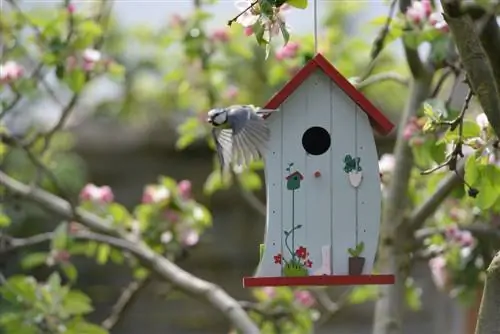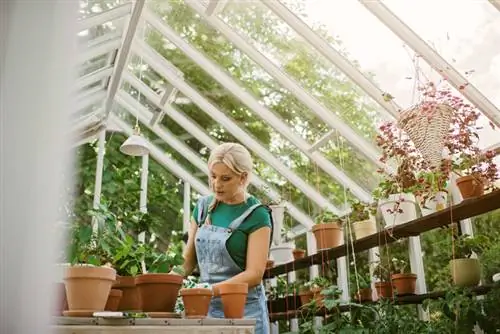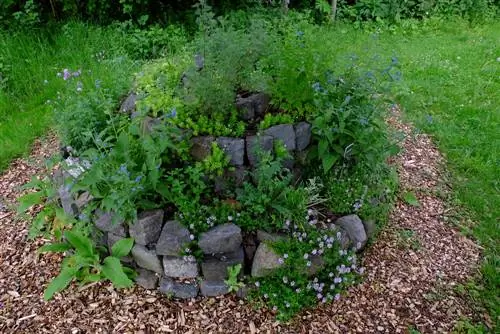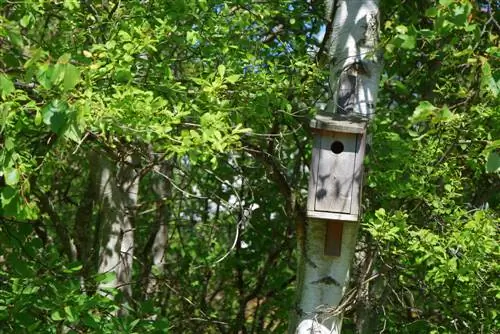- Author admin [email protected].
- Public 2023-12-16 16:46.
- Last modified 2025-06-01 06:02.
Happy bird chirping can only be heard from the nesting box when the direction, hanging height and distance are correct. The ideal location depends on whether it is a tit box or a semi-cave. Read this guide on how to hang a nesting box correctly.
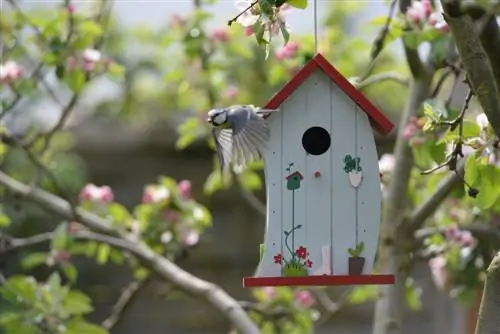
How should a nesting box be hung correctly?
When hanging a nesting box, the entry hole should face east or southeast, at a height of 1.5 to 3.5 meters for closed nesting boxes or 2 to 4 meters for half-caves. Ensure a distance of 10 meters for the same design or 3 meters for different designs.
- When hanging the nesting box, the ideal direction for the entrance hole is east or southeast.
- Bird lovers hang nesting boxes correctly at a distance of 10 m for the same type or 3 m for different types. No special distance needs to be maintained for colony breeders.
- A closed nesting box with an entry hole is hung in the tree at a height of 1.5 to 3.5 m. A half-cave nesting box is attached to the house wall at a height of 2 to 4 m.
Hang up the nesting box - which direction is correct?
If the entrance opening points in the right direction, you can look forward to a fully booked nesting box. So that the pelting rain doesn't flood the bird house or the blazing sun turns the nest into a sauna, do it right:
- ideal direction: nest box entrance hole faces east or southeast
- alternative orientation: Entry opening faces north or northeast
Heading west is taboo because in Central Europe, storms and rain particularly often hit the birdhouse from this direction. The south direction is unfavorable because hours of sunshine cause the delicate chicks to starve in the nesting box.
Excursus
Closed nesting box or half cavity - what's the difference?
Bird experts from NABU (German Nature Conservation Association) differentiate between two different nesting box models. The closed nesting box with entrance holes of different sizes invites titmice, sparrows and starlings to move in. In contrast, wrens, redstarts and robins prefer a semi-open nesting aid that mimics natural breeding sites in niches and rock crevices. As a rule, a semi-cave nesting box has a wide slit as an entrance, which allows in a lot of light and still offers a minimum of protection against voracious cats.
Where and at what height should a nesting box hang? - Location table
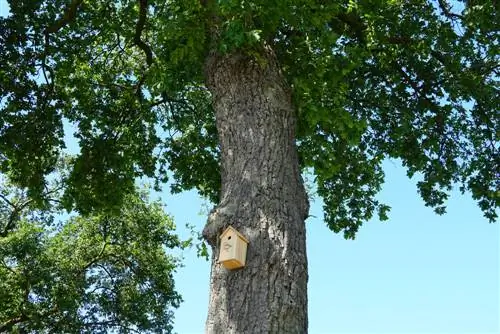
Tit boxes should be hung quite high
The location and hanging height for a nesting box are closely related to the type of bird that is to create its nursery in it. Nesting aids with a small entrance hole, such as a tit box, are best placed high up in the tree. The ideal place for the half-cave box is the wall of the house because the wide access poses a safety risk for the feathered residents. A location on the smooth facade keeps the nesting aid for robins out of the reach of predatory predators. The following table gives a summary overview of where and at what height you should hang a nesting box:
| Nest box with entrance hole | Half cave | |
|---|---|---|
| best location | Tree trunk | Building wall |
| alternative locations | + house wall | + Balcony |
| + Garden house/shed | + tree trunk | |
| Height | 1, 5-3, 5 m | 2, 0-4, 0 m |
| suitable for | + tits | + Robin |
| + Starlings | + Wren | |
| + Sparrows | + Redstart | |
| Height | 4, 0-10 m | |
| + Jackdaw | ||
| + Tawny Owl | ||
| + Little Owl |
The rule of thumb for the perfect hanging height is: the larger the bird species, the higher a nesting box should hang. Please make sure that there are no dense branches in the tree that prevent the birds from approaching. There should be no trellises with climbing plants in the immediate vicinity on the house wall or on the balcony, which clever cats could abuse as climbing aids.
In the following video, a knowledgeable bird expert from NABU has his say with lots of useful tips on where and how to properly hang a nesting box:

At what distance can you hang nesting boxes next to each other?
Bird lovers with a large garden don't just have to stick with a lonely nesting box and hang up several breeding sites. However, this laudable undertaking only finds the approval of picky female birds if the nesting boxes are not hung too close. The correct distance is directly related to the bird species in question. The NABU bird experts advocate the following distances between the nesting boxes:
- Nesting boxes of the same design: Minimum distance 10 m (e.g. with hole diameter 26-28 mm for tits)
- Nesting boxes for different bird species: Minimum distance 3 m (e.g. closed nesting boxes next to half-cave boxes)
An exception applies to colony breeders. Sparrows and starlings prefer to breed in a sociable place next to each other without any distance rules.
Tip
Treecreepers enjoy a special nesting aid with an entrance on the back. For this reason, there is an extra treecreeper nesting box with a rectangular slot at the top of the back wall. Knowledgeable bird lovers hang the box on the tree trunk so that the feathered climber can march straight into it.
When is the best time?

Autumn is the best time to hang up the nesting box
For a variety of reasons, fall is the best time to hang a nesting box. With the beginning of the dark, cold season comes the starting signal for the craft season, which already sets the course for a lively garden next year with self-built birdhouses. In fact, even outside the breeding season, a nesting box fulfills the life-saving function of providing winter quarters for birds, insects and small mammals such as dormice or squirrels.
You should hang up nesting boxes in the garden or on the balcony by the end of February/beginning of March at the latest. By this point, most bird species have completed their search for housing, moved into quarters and started family planning. Anyone who only installs the nesting aid for titmice, robins and starlings in spring will complain about emptiness in the first year and won't be able to admire the first chicks until the next breeding season at the earliest.
Hanging the nesting box on the balcony - what should you pay attention to?
Balcony gardeners with a big heart for homeless birds hang up a nesting box. The green balcony with lushly planted boxes, pots and buckets is very popular in our bird world as a blooming snack garden for insects. Where hordes of insects buzz, Mr. and Mrs. Titmouse have an easy time stuffing the hungry beaks of their chicks. The following tips summarize what else you should pay attention to when hanging a nesting box on the balcony:
- Minimum height 2-3 m
- Direction of entrance hole or half-cave entrance: east, southeast or north
- Location partially shaded to shady, ideally under a eaves
- sufficiently large distance from the seat
- no direct insight into the nesting box by curious human eyes
Please hang a nesting box on the balcony so that it does not swing back and forth. It hinders the stressed bird parents when every attempt to feed the chicks involves a daring balancing act. Avoid a perch. For magpies, jays and other nest robbers, approach poles are a welcome opportunity to land and attack the chicks.
How can you hang nesting boxes in the tree?
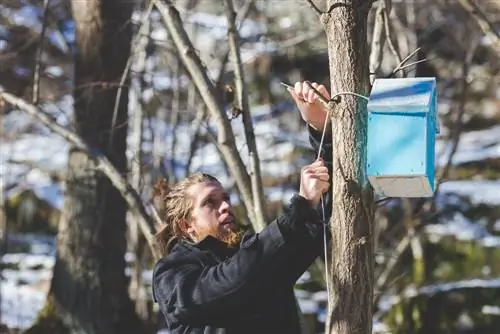
A nesting box is best hung on the tree and not nailed down
A tree should not suffer any damage if you hang a nesting box from the trunk. The following instructions explain how to do it correctly:
Material and tools
- Nestbox
- ladder
- 2 screw eyelets
- binding wire
- Wire cutters
- Garden hose
- Knife or scissors
Step-by-step instructions
- Screw in a screw eyelet in the upper, rear corner of each side wall (the nesting box should later tilt slightly forward)
- Cut off the binding wire (the correct length fits around the trunk and can be twisted at the eyelets later)
- Cut garden hose with knife or scissors
- Push the wire into the piece of hose (the ends of the wire stick out far enough to twist)
- Put one end of the wire through the eyelet and tighten it
- climb the ladder, place covered wire around the trunk over a thick side branch
- Tighten the second end of the wire with the eyelet
By placing the covered binding wire over a side branch around the trunk, you optimize stability because the nesting box cannot slip off.
Frequently asked questions
When should you hang nesting boxes?
The best time is in autumn. If you hang up one or more nesting boxes before the start of the cold season, numerous insects, birds and small mammals will use the wooden houses as winter quarters and protection from the bitter cold. If you missed the autumn deadline, there is nothing wrong with hanging up your self-made nesting box in the middle of winter. The nesting aid should be in place by the end of February at the latest so that expectant bird parents can move into the breeding site.
At what height should you hang a nesting box for squirrels?
The nesting box for squirrels is called a kobel and, in contrast to the bird box, has at least two entrances or exits. There is an opening in the floor as a safe escape route from voracious cats and martens. To protect yourself from predators, you should hang a squirrel tree high in the treetop, ideally at a height of 4 to 5 meters.
Where should you hang a nesting box?
It is best to hang a nesting box in partial shade or shade, well protected from the blazing midday sun. The entrance opening faces east because rain and storms usually come from the west. It is helpful if you hang the nesting box so that it is tilted slightly forward. In this way, rain can drain away easily and does not find its way into the bird's nest.
Why isn't a nesting box available?
Common causes for a yawning emptiness in the nesting box are a location in the blazing sun and an entry opening to the west. Birds ignore the most beautiful nesting boxes when direct sunlight hits them at midday. If it rains, young birds are doomed. For this reason, east is the perfect direction for the entrance gate.
Tip
Hanging a nesting box on the balcony is the first step on the way to a bird oasis of well-being. The perfect equipment also includes a bird bath, a sand bath for plumage care, flowering herbs, privacy bushes as hiding places and delicious strawberries in the balcony box. Don't forget some pretty stickers for the window pane so that your feathered lodgers don't hit their heads.

